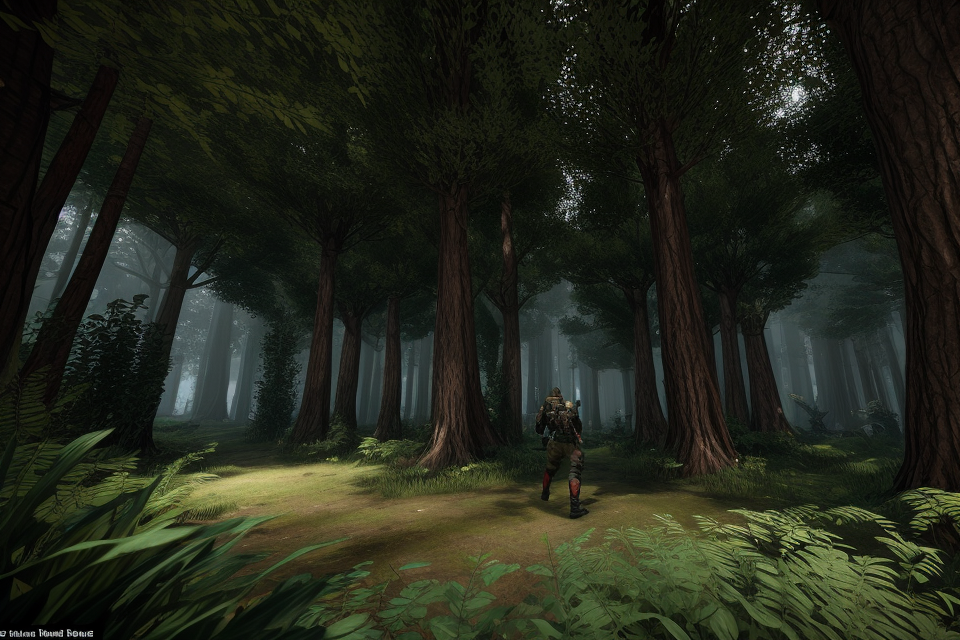Stealth games were once a staple in the gaming world, with titles like Metal Gear Solid and Splinter Cell captivating players with their thrilling gameplay and intricate storylines. However, in recent years, the genre seems to have disappeared from the gaming landscape. In this article, we’ll explore the reasons behind the decline of stealth games and what the future holds for this once-popular genre.
Stealth games, which involve sneaking around and avoiding detection by enemies, have largely disappeared from the gaming world in recent years. One reason for this is that the genre has become somewhat stale, with many games using similar mechanics and gameplay elements. Additionally, the rise of more action-oriented and multiplayer-focused games has made it harder for stealth games to stand out and find an audience. However, there are still some developers working on stealth games, and the genre may experience a resurgence in popularity in the future.
The Rise and Fall of Stealth Games
The Origins of Stealth Games
Early examples of stealth games
Stealth games have been around for decades, with some of the earliest examples dating back to the 1980s. One of the first stealth games was “Sneakers,” released in 1989 for the Commodore 64. The game followed the player as they navigated through a series of levels, avoiding guards and sneaking past security checkpoints.
Another early example of a stealth game was “Metal Gear,” which was first released in 1987 for the MSX2 computer. The game was developed by Konami and featured a solider named Solid Snake as the main character. Snake was tasked with infiltrating enemy bases and taking out high-value targets, using stealth and cunning to avoid detection.
The evolution of stealth game mechanics
As stealth games evolved, so did the mechanics that governed them. In the early days, stealth games were often focused on simply avoiding detection by guards or other enemies. However, as the genre matured, game designers began to incorporate more complex mechanics, such as stealth kills, disguises, and environmental manipulation.
One of the most influential stealth games of all time was “Thief: The Dark Project,” which was released in 1998 for the PC. The game was set in a dark, gothic city and featured a master thief named Garrett as the main character. Players had to navigate through the city, avoiding guards and stealing valuable items, using a combination of stealth, combat, and exploration.
As the 2000s rolled around, stealth games continued to evolve, with new mechanics and features being introduced with each passing year. Games like “Half-Life 2” and “Splinter Cell” brought new levels of interactivity and immersion to the genre, allowing players to sneak around, use gadgets, and engage in combat when necessary.
Despite the continued evolution of stealth games, the genre has largely disappeared from the gaming world in recent years. In the next section, we’ll explore some possible reasons why this might be the case.
The Golden Age of Stealth Games
Stealth games have been a beloved genre among gamers for decades, offering players the thrill of sneaking around and avoiding detection. The golden age of stealth games, which lasted from the late 1980s to the early 2000s, saw the release of some of the most iconic and influential stealth games of all time.
Some of the stealth games that defined the genre during this time include:
- Metal Gear: The first game in the legendary Metal Gear series, released in 1987, was a groundbreaking stealth game that introduced many of the genre’s core mechanics, such as hiding in boxes and using distractions to avoid enemies.
- Splinter Cell: The first Splinter Cell game, released in 2002, was a critically acclaimed stealth game that emphasized player choice and provided multiple paths for players to complete objectives.
- Thief: The first Thief game, released in 1998, was a pioneering stealth game that featured a dark, gritty world and challenging puzzles.
During this time, several popular stealth game franchises emerged, including:
- Metal Gear Solid: The sequel to the original Metal Gear game, released in 1998, expanded on the original’s gameplay mechanics and told a complex, engaging story.
- Splinter Cell: The sequels to the original Splinter Cell game, released in 2004 and 2005, continued to refine the series’ gameplay and featured even more challenging missions.
- Thief: The sequels to the original Thief game, released in 2000 and 2002, continued to build on the series’ strengths and added new gameplay mechanics, such as lockpicking and trap disarming.
Despite the success of these games and franchises, stealth games have largely disappeared from the gaming world in recent years. This article will explore the reasons behind this decline and examine the future of the stealth game genre.
The Decline of Stealth Games
Factors contributing to the decline
The decline of stealth games can be attributed to several factors, including:
- Saturation of the market: With the proliferation of stealth games in the late 1990s and early 2000s, the market became saturated, leading to a decline in the popularity of the genre.
- Shift in gaming trends: As gaming trends shifted towards more action-oriented and open-world games, stealth games struggled to maintain their relevance.
- Difficulty in innovation: The genre became stagnant, with few new ideas or innovations to keep it fresh and engaging for players.
Lack of innovation in the genre
One of the primary reasons for the decline of stealth games is the lack of innovation within the genre. Many stealth games released in the past few years have relied heavily on the same gameplay mechanics and concepts that were popularized in the early 2000s. As a result, the genre has become stale, with few new ideas or innovations to keep it fresh and engaging for players.
Furthermore, the lack of innovation has led to a lack of critical acclaim for stealth games, with many reviewers and players feeling that the genre has become stagnant and uninspired. This has further contributed to the decline of stealth games in the gaming world.
In conclusion, the decline of stealth games can be attributed to several factors, including saturation of the market, shifts in gaming trends, and a lack of innovation within the genre. Despite these challenges, there is still a strong community of stealth game fans who continue to enjoy and play these games, and there is hope for a resurgence in the popularity of the genre in the future.
Exploring the Reasons Behind the Disappearance
Market Trends and Consumer Demands
- The shift towards open-world and action games
- As the gaming industry has evolved, there has been a noticeable shift towards open-world and action games. These games often prioritize fast-paced gameplay, combat mechanics, and exploration, which have become increasingly popular among gamers. Open-world games like Assassin’s Creed and GTA series, and action games like Call of Duty and Battlefield have seen immense success in recent years, overshadowing the popularity of stealth games.
- The impact of battle royale games on the industry
- The rise of battle royale games like Fortnite and PlayerUnknown’s Battlegrounds (PUBG) has significantly impacted the gaming world. These games have captivated audiences with their unique blend of survival, exploration, and PvP elements. The immense success of battle royale games has not only influenced the development of new games but also redirected the focus of developers and players alike, leading to a decline in the popularity of stealth games.
In summary, the shift towards open-world and action games, coupled with the emergence of battle royale games, has led to a decline in the popularity of stealth games in the gaming world. The preferences of consumers and market trends have played a crucial role in shaping the gaming landscape, with genres like stealth games struggling to maintain their prominence.
Technological Limitations
- Challenges in creating realistic stealth mechanics
- Stealth games require a high degree of player immersion, where the player must navigate through environments undetected and make strategic decisions to avoid detection. However, creating realistic stealth mechanics can be challenging due to technical limitations.
- For example, in a stealth game, the player may need to hide behind objects or sneak past guards, but the game must be able to accurately simulate the behavior of these objects and characters in real-time. This requires a high level of processing power and sophisticated AI algorithms, which can be difficult to implement on current gaming hardware.
- The limitations of current gaming hardware
- Stealth games often require complex and detailed environments, which can be difficult to render on current gaming hardware. For example, in a game like “Metal Gear Solid,” the player must navigate through large, open environments while avoiding detection by guards and other enemies. This requires a high level of processing power and memory, which can be a challenge for many gaming systems.
- Additionally, stealth games often require precise controls, where the player must move and aim with a high degree of accuracy. However, many gaming controllers and input devices may not be able to provide the necessary level of precision, which can detract from the overall gameplay experience.
- As a result, many game developers have shifted away from stealth games in favor of other genres that are easier to develop and more accessible to a wider audience.
The Rise of Indie Developers
- The role of indie developers in keeping the genre alive
- Independent game developers have played a crucial role in the survival of the stealth game genre.
- These developers often have a passion for the genre and are not constrained by the commercial pressures faced by larger studios.
- They are able to take more risks and experiment with new ideas, leading to a renewed interest in stealth games.
- Successful indie stealth games in recent years
- “Invisible Inc” (2019) – A turn-based stealth game developed by indie studio Klei Entertainment.
- “Honor Among Thieves” (2014) – A stealth game developed by Smoking Gun Interactive, a small indie studio.
- “Mark of the Ninja” (2012) – A side-scrolling stealth game developed by Canadian indie studio, Klei Entertainment.
- “Limbo” (2010) – A dark, atmospheric puzzle-platformer with stealth elements, developed by Danish indie studio, Playdead.
- “Super Motherload” (2014) – A cooperative stealth-action game developed by Pixel Federation, a small indie studio.
- “Subterfuge” (2015) – A turn-based strategy game with stealth elements, developed by Pixelmatic, a small indie studio.
- “Gunpoint” (2013) – A stealth-action game developed by Tom Francis, an independent game developer.
- “Intruder” (2019) – A procedurally generated stealth game developed by Canari Games, a small indie studio.
- “Shadow Tactics: Blades of the Shogun” (2016) – A team-based stealth game developed by German indie studio, Mimimi Games.
- “Aegis Defenders” (2018) – A tower defense game with stealth elements, developed by Humble Bundle, an indie game distributor.
- “Minit” (2018) – A time-limited stealth game developed by indie studio, Deux Button Studios.
- “Observation” (2019) – A sci-fi thriller game with stealth elements, developed by UK-based indie studio, No Code.
- “Dishonored” (2012) – A first-person stealth game developed by Arkane Studios, an indie game developer.
- “Death of the Outsider” (2017) – A standalone expansion to the stealth game “Dishonored 2”, also developed by Arkane Studios.
- “Ghost of Tsushima” (2020) – An action-adventure game with stealth elements, developed by Sucker Punch Productions, an indie studio.
- “Outer Wilds” (2019) – A space exploration game with stealth elements, developed by indie studio, Mobius Digital.
- “Ruiner” (2019) – A cyberpunk stealth game developed by Polish indie studio, Reikon Games.
- “Secondhand Souls” (2018) – A stealth game developed by Canadian indie studio, Copper Candle Games.
- “The Shattering” (2019) – A narrative-driven stealth game developed by Australian indie studio, Stormbird Games.
- “Thief” (2014) – A reboot of the classic stealth game series, developed by Eidos Montreal, an indie studio.
- “We. The Revolution” (2019) – A courtroom simulation game with stealth elements, developed by Polish indie studio, Pol Azur.
- “The Church in the Darkness” (2019) – A psychological horror game with stealth elements, developed by
The Future of Stealth Games
A Renewed Interest in Stealth Mechanics
- The resurgence of interest in stealth games
In recent years, there has been a noticeable uptick in the popularity of stealth games among gamers. This resurgence of interest can be attributed to several factors, including the rise of indie developers, the increasing sophistication of gaming technology, and the growing demand for more diverse gaming experiences.
- The influence of stealth mechanics in other genres
Stealth mechanics have also been incorporated into other genres, such as first-person shooters and action-adventure games. This has helped to broaden the appeal of stealth games to a wider audience and has encouraged developers to experiment with new and innovative ways to incorporate stealth mechanics into their games.
Furthermore, the success of popular stealth games like “PlayerUnknown’s Battlegrounds” and “Fortnite” has demonstrated that there is a significant market for games that incorporate stealth mechanics. This has led to a renewed interest in stealth games among both developers and gamers, and it is likely that we will see a resurgence of stealth games in the coming years.
New Approaches to Stealth Game Design
Innovative Ways to Incorporate Stealth Mechanics
As the gaming industry continues to evolve, so too does the design of stealth games. Innovative ways to incorporate stealth mechanics are being explored by game developers, aiming to revitalize the genre and provide players with fresh and exciting experiences. These new approaches may include:
- Integrating stealth mechanics into open-world environments, allowing players to freely explore and navigate while using stealth techniques to avoid detection.
- Incorporating stealth elements into multiplayer games, creating new gameplay opportunities for players to work together or compete against each other using stealth tactics.
- Incorporating stealth mechanics into survival horror games, adding a new layer of tension and challenge for players as they attempt to navigate through frightening environments while remaining undetected.
Potential New Features and Gameplay Elements
In addition to innovative ways of incorporating stealth mechanics, new features and gameplay elements are being explored to enhance the stealth game experience. These may include:
- Advanced AI systems that create more realistic and challenging opponents for players to evade.
- A greater emphasis on player choice and consequence, allowing players to approach stealth situations in a variety of ways and face the consequences of their actions.
- Improved graphics and technology, allowing for more immersive and realistic environments for players to navigate while using stealth techniques.
As the gaming world continues to expand and evolve, the future of stealth games looks bright with new approaches to game design and exciting new features and gameplay elements on the horizon.
The Role of Fan Demand
- The importance of fan support in the development of new stealth games
- The potential for fan-driven game development
The Role of Fan Demand
In the world of gaming, it is evident that the preferences of the players have a significant impact on the type of games that are developed. Stealth games, once a popular genre in the gaming world, have seemingly disappeared from the market. This section will delve into the role that fan demand plays in the development of new stealth games and the potential for fan-driven game development.
The Importance of Fan Support
Fan support is a crucial factor in the development of new games, including stealth games. Developers often look to the community to gauge interest in a particular genre or type of game. If there is a significant demand for stealth games, developers are more likely to invest time and resources into creating new titles in the genre. On the other hand, if the demand is low, developers may choose to focus their efforts on other genres.
The Potential for Fan-Driven Game Development
Another factor that has contributed to the decline of stealth games is the changing landscape of game development. In recent years, there has been a shift towards more accessible and streamlined gameplay experiences. This has led to a decrease in the number of games that require a high level of skill and precision, such as stealth games.
However, there is still a dedicated community of fans who are passionate about stealth games and are willing to support their development. This presents an opportunity for fan-driven game development, where fans can come together to fund and support the creation of new stealth games. This approach has been successful in the past, with projects such as Shadow Warrior and Wasteland 2 being successfully funded through crowdfunding.
In conclusion, the role of fan demand is crucial in the development of new stealth games. While the genre may have fallen out of favor with mainstream developers, there is still a dedicated community of fans who are passionate about stealth games and are willing to support their development. The potential for fan-driven game development offers a glimmer of hope for the future of stealth games, and could potentially lead to a resurgence in the popularity of the genre.
FAQs
1. Why have stealth games disappeared from the gaming world?
Stealth games, which were once a popular genre in the gaming world, have largely disappeared in recent years. There are several reasons for this, including changes in player preferences, the rise of more action-oriented games, and the difficulty of creating new and innovative stealth gameplay mechanics. Additionally, many players now prefer more accessible and less challenging games, which has led to a decline in the popularity of stealth games.
2. What is a stealth game?
A stealth game is a type of video game in which the player must use stealth and cunning to avoid detection by enemies and complete objectives. These games often involve sneaking around levels, avoiding guards, and using the environment to conceal the player’s movements. Examples of popular stealth games include the Metal Gear series, Hitman series, and Thief series.
3. Are there any new stealth games being developed?
While the popularity of stealth games has declined in recent years, there are still some developers working on new stealth games. However, these games are often smaller in scope and are not as widely marketed or promoted as they once were. As a result, they may not be as well-known to players who are not actively seeking out new stealth games.
4. Can stealth games still be enjoyable in today’s gaming landscape?
Yes, stealth games can still be enjoyable in today’s gaming landscape, especially for players who enjoy a challenge and appreciate the strategic elements of gameplay. While the genre may not be as popular as it once was, there are still many classic stealth games that are worth playing, and some newer games that offer unique twists on the genre.









